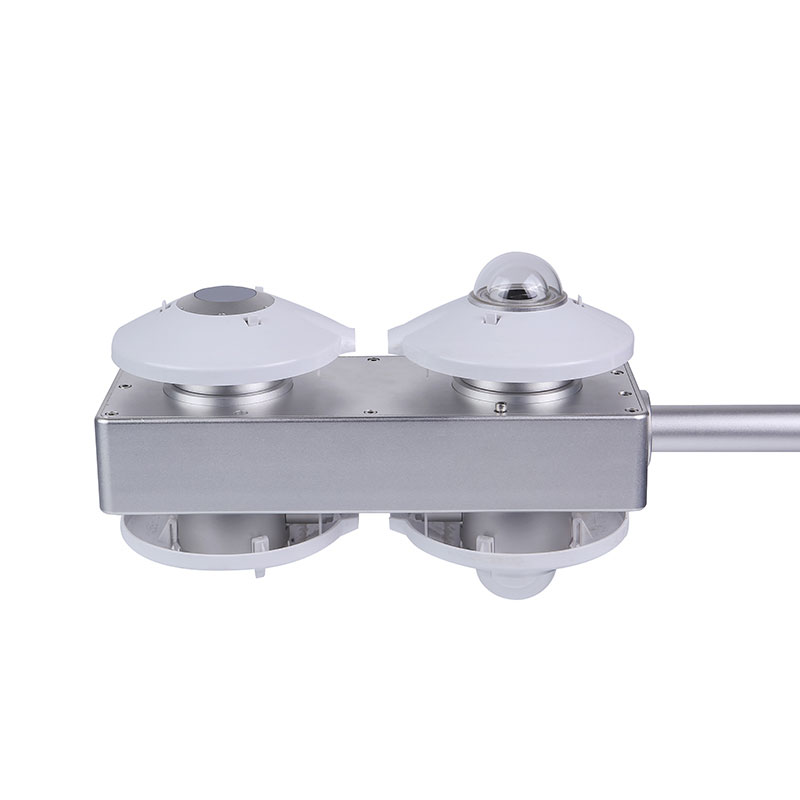Shandong Fengtu IOT Technology Co., Ltd
Sales Manager:Ms. Emily Wang
Cel,Whatsapp,Wechat:+86 15898932201
Email:info@fengtutec.com
Add:No. 155 Optoelectronic Industry Accelerator, Gaoxin District, Weifang, Shandong, China

Sales Manager:Ms. Emily Wang
Cel,Whatsapp,Wechat:+86 15898932201
Email:info@fengtutec.com
Add:No. 155 Optoelectronic Industry Accelerator, Gaoxin District, Weifang, Shandong, China

Model:FT-FS7H
Brand:fengtu
1. 4-Component Net Radiometer Product Overview
In meteorological applications, infrared radiation or long-wave radiation refers to electromagnetic radiation with a wavelength greater than 3.0 μm. Long-wave radiation is physically related to temperature and is emitted by all objects on Earth. The spectrum of the sun's short-wave radiation is from 300 nm to 3 μm (accounting for 99.5% of the total solar radiation).
Fengtu's FT-FS7H four-component net radiation sensor directly measures daily longwave radiation and shortwave radiation and calculates the net radiation. It is used for meteorological observations of atmospheric radiation (radiation emitted by clouds/water vapor and carbon dioxide, etc.) and net radiation exchange between the earth and the atmosphere. Net total radiation (shortwave + longwave) is usually measured by 4 net radiometers or a single net radiometer (whose detector can respond to the full band). The earth's longwave radiometer uses a detector with a hemisphere facing upward to measure the longwave radiation emitted downward. The net longwave radiation and the downward emitted radiation of the earth-atmosphere system can be calculated. It has been widely used in meteorology/photovoltaics/horticulture/agriculture and industry.
2. Features of 4-Component Net Radiometer
1. Comply with the WMO World Meteorological Organization Guide (CIMO Guide)
2. Strong sensitivity to infrared radiation with a wavelength of 4 to 50 µm
3. The error caused by the heat of the silicon cover is small
4. Small cosine response error
5. Reduce environmental impact
6. Good stability
3. 4-Component Net Radiometer Technical Specifications
| Technical Parameters | Technical Description |
| Total radiation | |
| Grade Standard | FIRST CLASS |
| Time response (95%) | 13s |
| Thermal radiation zero offset | ±10W/m2 |
| Temperature change zero offset | ±3W/m2 |
| Nonlinear | ±1.5% |
| Instability | ±1% |
| Directional response | ±18 W/m2 |
| Spectral error | ±3% |
| Temperature response (-10~40℃) | 3% |
| Tilt error | ±1% |
| Spectral response | 285~3000nm |
| Daily sampling accuracy | <5% |
| Resolution | 1W/m2 |
| Sensitivity | 7~14μV/W•m-2 |
| Signal output | 0~20mV |
| Earth Radiation | |
| Spectral response | 400~50000nm |
| Response time (sec) 95% | <18s |
| Instability (change/year) | <2% |
| Temperature coefficient | ≤±1%(-20℃~+50℃) |
| Perspective | 180° |
| Sensitivity (µV/W/m²) | 2~150uV/Wm-2 |
| Impedance(Ω) | 20~140 |
| Window heating offset | <4W/m2 (when solar radiation is 1000W/m2) |
| Signal range | -500~+500 W/m² |
| Signal output | -20~0mV |
| General Parameters | |
| Number of channels | 4 channels mV, 2 channels 4-wire platinum resistance |
| Temperature Sensor | Linear platinum resistance (JIS standard: c-1604-1989) |
| Operating temperature | -40~+70℃ |
| weight | 9kg |
The solar automatic weather station uses solar energy to generate electricity. Because it is equipped with a solar panel, it can operate in the field for a long time without being affected by the power supply. Moreover, it is fully automatic and realizes remote weather monitoring. Users only need to...
On the stage of nature, agriculture and meteorology are an inseparable pair of dancing partners. The growth, development, yield, and quality of agricultural crops are all directly affected by the weather. Temperature, light, and moisture, these three meteorological elements, constitute the cornersto...
Environmental Monitoring Station captures the concentration of negative oxygen ions in the air around the clock, relying on IoT technology to provide data support for environmental health and ecological value....
In today's era of pursuing health and ecology, more and more scenic spots have introduced Negative Oxygen Ion Monitoring Stations, equipped with smart large screens. This initiative not only adds technological elements to the scenic spots but also is closely related to tourists' health and e...